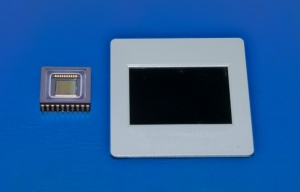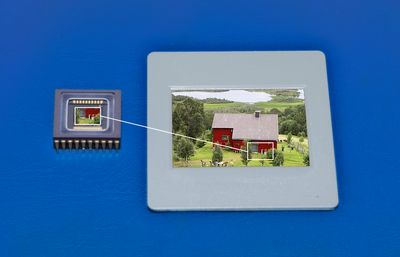Crop factor
There is a lot of talk about crop factors, unless you are used to take pictures with a certain camera system and know the details about focal length and angle of view you can safely ignore it. Just use the lens that gives the result you are looking for and everything will work out fine.
Crop factor calculation
- <math>\mbox{Crop}\; \mbox{factor} = \frac{\mbox{Original}\; \mbox{sensor}\; \mbox{size}}{\mbox{New}\; \mbox{sensor}\; \mbox{size}}</math>
The picture shows a CCD chip from a digital camera and a traditional film frame. The CCD chip has a size of 7 mm and the film has a size of 35 mm. The common definition of original size is 35 mm but it depends on what systems you are comparing. That gives us a crop factor of:
- <math>\frac{35\; \mbox{mm}}{5\; \mbox{mm}} = 5x</math>
This means that to get the same picture a camera using the small sensor must use a focal length that is 5 times shorter.
It is clear that the small sensor can only fit a small portion of the image that fills the larger sensor. This is why it is called crop factor, the small sensor is only able to to fit a crop of the original picture. Making the focal length 5 times shorter will make the picture five times smaller and it will be able to fit on the small sensor.
Common sensor sizes
- Nikon D70 - 23.7 x 15.6 mm
- Nikon D200 - 23.6 x 15.8 mm
- Canon 350D/400D - 22.2 x 14.8 mm
- Canon 20D/30D - 22.5 x 15 mm

